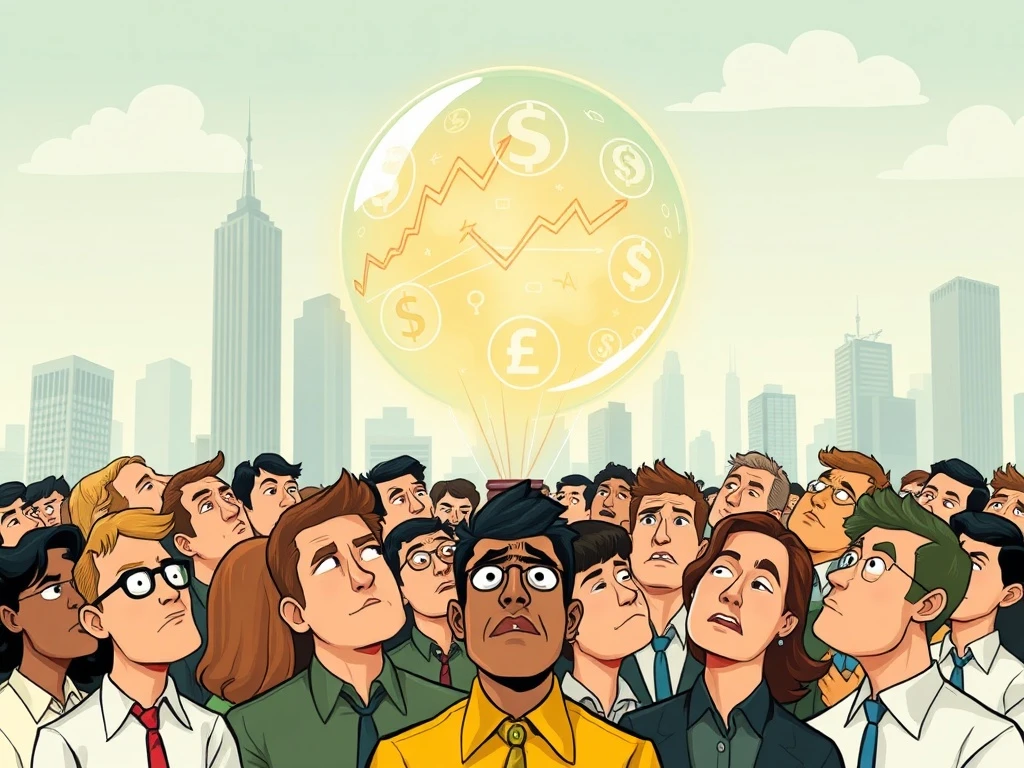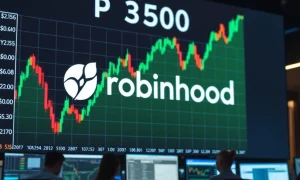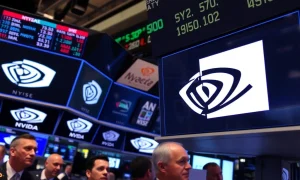Many investors are currently experiencing a potent mix of FOMO, envy, and greed. These powerful emotions often emerge during periods of rapid market ascent. Record stock prices can create a pervasive sense of missing out. This collective sentiment is not new. In fact, it frequently signals the potential formation of market bubbles. Understanding these phenomena is crucial for informed financial decisions.
Understanding Market Bubbles: When Prices Detach from Value
A market bubble occurs when asset prices rise significantly above their intrinsic value. This surge is primarily fueled by speculative buying rather than underlying fundamentals. Investor behavior becomes increasingly detached from traditional valuation metrics. Consequently, the price increase becomes unsustainable. Eventually, the bubble bursts. This leads to a rapid and often dramatic price decline. History shows this pattern repeats across different asset classes. Furthermore, it impacts various markets globally. Identifying these periods requires a clear understanding of their characteristics.
During a bubble, prices escalate because buyers believe they can sell assets at an even higher price to someone else. This concept is often called the “greater fool theory.” People buy simply because prices are rising. They expect them to continue rising indefinitely. However, this speculative fervor cannot last forever. There are no new buyers at ever-increasing prices. Therefore, the demand eventually collapses. This triggers the rapid unwinding of the bubble.
The Psychology Behind Market Bubbles: Emotions in Motion
Human psychology plays a critical role in forming market bubbles. Emotions like FOMO (Fear Of Missing Out) drive many decisions. Investors fear being left behind. They see others making quick profits. This creates immense pressure to participate. Greed also fuels this speculative frenzy. People want to maximize returns quickly. They often take on excessive risk. Envy arises from seeing others succeed effortlessly. These feelings can easily override rational judgment. Moreover, cognitive biases contribute to this irrationality. For instance, confirmation bias leads investors to seek information that supports their optimistic views. They ignore contradictory evidence.
Herd mentality then takes over. Investors follow the crowd. They buy assets even at inflated prices. This collective behavior pushes valuations higher. It creates a self-fulfilling prophecy, until the inevitable correction. People feel a powerful urge to conform. They believe the crowd possesses superior information. This makes them ignore their own skepticism. Ultimately, these powerful emotional forces distort market signals. They propel prices far beyond sustainable levels.
Historical Market Bubbles: Learning from the Past
History offers clear examples of market bubbles. These events show consistent patterns. Understanding them helps identify current risks. The Tulip Mania of the 17th century is perhaps the earliest documented bubble. Tulip bulb prices in the Netherlands soared to astronomical levels. People mortgaged homes to buy them. This frenzy lasted for years. Eventually, the market crashed. Many investors faced ruin.
The Dot-com bubble of the late 1990s is a more recent prime example. Technology stocks saw unprecedented growth. Valuations soared without corresponding profits. Many companies had no revenue. Investors poured money into them anyway. Consequently, the bubble burst in 2000. Millions of dollars were lost. Similarly, the US housing market experienced a massive bubble in the mid-2000s. Mortgage lending standards loosened significantly. Housing prices rose unsustainably. Speculation was rampant. This bubble popped in 2008. It triggered a global financial crisis. These instances demonstrate the cyclical nature of market bubbles and their devastating aftermath.
Common Signs of Emerging Market Bubbles: What to Watch For
Identifying a potential market bubble requires vigilance. Several indicators often precede a burst. Understanding these signs can help investors make more informed decisions. Let’s explore some key red flags:
- Rapid Price Appreciation: Asset prices climb quickly and steeply. This rise often lacks fundamental justification. The speed of ascent is a major concern.
- High Valuations: Traditional valuation metrics, like price-to-earnings (P/E) ratios, become extreme. This suggests assets are significantly overvalued compared to their historical averages or underlying earnings.
- Increased Speculative Activity: Many new investors enter the market. They often chase quick gains. Trading volumes surge. There is a notable increase in leveraged positions.
- Emergence of ‘New Paradigm’ Thinking: Proponents argue ‘this time is different.’ They claim old rules no longer apply. They justify inflated prices with novel theories.
- Easy Credit Conditions: Low interest rates and readily available loans encourage borrowing. This fuels asset purchases. It inflates demand artificially.
- Widespread Public Participation: Everyone seems to be investing. Even people with no prior financial experience participate. This often signals a market top.
- Lack of Skepticism: Critical voices are often dismissed or ridiculed. There is a general consensus that prices will only go up.
These collective signs point towards potential market bubbles. Investors should approach such periods with caution. They must prioritize risk management.
Strategies for Navigating Volatile Markets and Market Bubbles
Prudent investors adopt specific strategies. These approaches help navigate periods of high volatility. They also offer protection against market bubbles. Implementing these tactics can preserve capital and even uncover opportunities.
Firstly, maintain a long-term investment horizon. Focus on your financial goals. Do not react to short-term fluctuations. A long-term view helps filter out market noise. Secondly, diversify your investment portfolio. Spread investments across different asset classes. Include stocks, bonds, real estate, and commodities. This reduces concentration risk. Furthermore, diversify within asset classes across different sectors and geographies. Thirdly, regularly rebalance your portfolio. Sell assets that have become overweighted due to price increases. Buy assets that are undervalued. This maintains your desired risk level. It also ensures you are not overly exposed to any single area.
Fourthly, avoid emotional decision-making. Stick to your investment plan. Do not let FOMO or greed dictate choices. Emotional reactions often lead to poor outcomes. Fifthly, focus on fundamental analysis. Invest in companies with strong earnings. Look for solid business models and sustainable competitive advantages. Do not chase speculative trends or unproven technologies. Lastly, build a substantial cash reserve. This provides liquidity during downturns. It also offers opportunities to buy assets at lower, more attractive prices. Additionally, consider consulting a qualified financial advisor. They can provide personalized guidance. They help you create a robust investment plan. These strategies promote resilience against market bubbles and foster long-term financial health.
Conclusion: Prudence in an Irrational World
The allure of rapidly rising markets is undeniable. However, the emotional pull can lead to irrational decisions. Understanding how market bubbles form is crucial for every investor. Recognizing their signs empowers individuals to act prudently. By adopting disciplined strategies, individuals can protect their wealth. Focus on long-term goals. Prioritize diversification. Avoid the herd mentality. Ultimately, prudence and patience remain paramount. These qualities help navigate the inherent risks of financial markets. They allow investors to build sustainable wealth, even when others succumb to speculative frenzies.
Frequently Asked Questions (FAQs)
Q1: What is the primary cause of market bubbles?
A1: Market bubbles primarily form due to a combination of excessive speculation, easy credit conditions, and powerful psychological factors like FOMO, greed, and herd mentality. These elements push asset prices far beyond their intrinsic value.
Q2: How do market bubbles typically burst?
A2: Market bubbles burst when the supply of new buyers willing to pay inflated prices diminishes. This can be triggered by rising interest rates, a change in economic outlook, or a major news event. Once buying pressure subsides, a sell-off begins, leading to rapid price declines as investors rush to exit.
Q3: Can governments or central banks prevent market bubbles?
A3: Governments and central banks can implement policies to mitigate the risk of market bubbles, such as adjusting interest rates or tightening lending standards. However, completely preventing bubbles is challenging due to their psychological and speculative drivers, which are difficult to control.
Q4: What should an individual investor do if they suspect a market bubble?
A4: If you suspect a market bubble, focus on risk management. This includes diversifying your portfolio, rebalancing regularly, maintaining a cash reserve, and prioritizing fundamental analysis over speculative trends. Avoid making emotional decisions based on FOMO or greed.
Q5: Are all rapid market increases indicative of a market bubble?
A5: Not necessarily. Rapid market increases can sometimes be justified by strong economic growth, technological advancements, or increased corporate earnings. A true market bubble is characterized by prices rising significantly without corresponding improvements in underlying fundamentals, driven purely by speculation.
Q6: How long do market bubbles typically last?
A6: The duration of market bubbles varies significantly. Some, like the Tulip Mania, lasted a few years, while others, like the Dot-com bubble, developed over several years before bursting. There is no fixed timeline, as their duration depends on the underlying speculative fervor and market conditions.
























